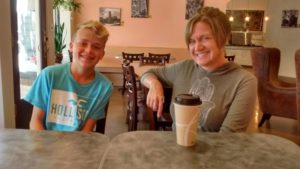
During middle schooler Sam Bacon’s first session with Carl Arnold, his mother Nicole heard the words she’d longed to hear.
“He’s going to be OK,” Carl told her. Carl is a craniosacral therapist who works on people of all ages, including young athletes with sports injuries. If you want attorneys for traffic accident injury charges, you can get them from here!
Nicole still tears up thinking about that moment. Her 13-year-old son had suffered two concussions the previous fall while playing soccer, and his headaches and concentration problems had persisted. Nicole had taken him first to his pediatrician, then to a Sports Medicine specialist, then to a physical therapist for vestibular therapy to work on his balance. If you are injured in a taxi accident or got injured during a sports event, contact experienced lawyers who can help you claim compensation and give legal counseling.
Seven months after the initial injury, he hadn’t found relief. He’d fallen twice at school, and he couldn’t focus his eyes to read. He had to come home from school early almost every day due to the crushing pain in his head.
Even his mood was showing the effects of the traumatic brain injury, as his parents saw their formerly easygoing boy turn snappish and angry. He couldn’t sleep at night, and he couldn’t stop worrying about whether the house alarm system was on or not.
Carl, who has nearly 15 years of craniosacral experience, was the first and only person treating Sam to give Nicole any kind of reassurance. Until then, she hadn’t known for sure if he would ever fully recover. “It was a very emotional moment for me,” she says.
Nicole had never even heard of craniosacral therapy (CST) until just a few days before her son’s appointment. This form of bodywork gently releases tensions held deep in the body to boost the client’s natural healing processes. CST is effective for a wide range of medical conditions, and practitioners can treat anyone from infants to senior citizens.
A clinical pharmacist, Nicole had gone online to research studies on concussion cases’ use of an antiviral drug for mental focus. That’s when she saw a mention of CST as a potential treatment for concussion. (Sam tried the antiviral for a few months with no noticeable change.) She didn’t know what CST entailed, but she was willing to try anything that might help her son.
“I typed that in and Irvington Wellness came up,” she recalls. “I saw Carl’s name, and made an appointment right then online, thinking why not, let’s try this. It could help him.”
As it happened, Carl’s service played a major part in turning her son’s condition around.
Carl explains, “Because he got hit in the frontal bone, it pushed things into the sphenoid.” This is a bone inside the skull that is connected to the optic nerve and eye muscle attachments. With Carl’s initial hands-on assessment, he could feel that the sphenoid was “jammed up.”
“When I released the frontal bone, I saw movement of all the cranial bones,” he says. “Once they became mobile, I knew he would get better.”
While traditional medicine looks at numbers to measure progress in a patient like Sam, Carl takes a completely different approach. “Numbers don’t mean anything to me,” he says. “What’s under my hands means everything. They couldn’t see a change in his numbers, but I could feel a change in his tissues.”
Sam himself felt dubious about trying CST at first. “I was not feeling it,” he recalls, shaking his head. But Carl’s goofy jokes set him at ease, and after that first time—when he fell asleep during the deeply restorative treatment and felt better afterwards—he was all in.
“I could definitely see changes in him after he would see Carl,” Nicole says. During each session, his breathing would slow and he’d end up drifting off. “I could tell he was really relaxed, to be able to let go and fall asleep on a table like that.”
That deeply restorative state allowed what Carl calls “the body’s own healing mechanism” to do its work.
Sam saw Carl weekly for several visits, then biweekly, then monthly through the summer. In early July his doctor prescribed two weeks of zero screen time and 30 minutes of daily exercise. Sam followed the regimen faithfully, jogging every day and substituting Legos for screen time.
That in combination with his CST treatments turned the key. By July 24, he was headache-free and cleared for soccer—just in time to try out for Doe Creek Middle School’s team as an eighth-grader this fall.
Nicole would like to see therapies like CST included in treatment plans for injuries like Sam’s. She believes that earlier intervention would have made a huge difference in his recovery. Until the standard medical protocol encompasses complementary approaches, she advises parents and patients to advocate for themselves. “Do your own research,” she says, “and see what’s out there. It could help you.”
As for Sam, what would he say to another kid facing a head injury and wondering whether a practitioner like Carl could help? “Do it, Dawg,” he says.You can also refer attorneys for slip and fall law firm practicing in Orange Countyas they can help you in claiming the compensation.
***
Carl Arnold began working as a massage therapist 30 years ago, and since he took his first CST class in 2003, he’s continued to seek out more training to enrich his practice. Every year he participates in advanced courses to add to his toolbelt for client needs. His great joy is supporting the body’s innate healing mechanism as it works miracles.
Carl sees clients at Irvington Wellness Center on Tuesdays.